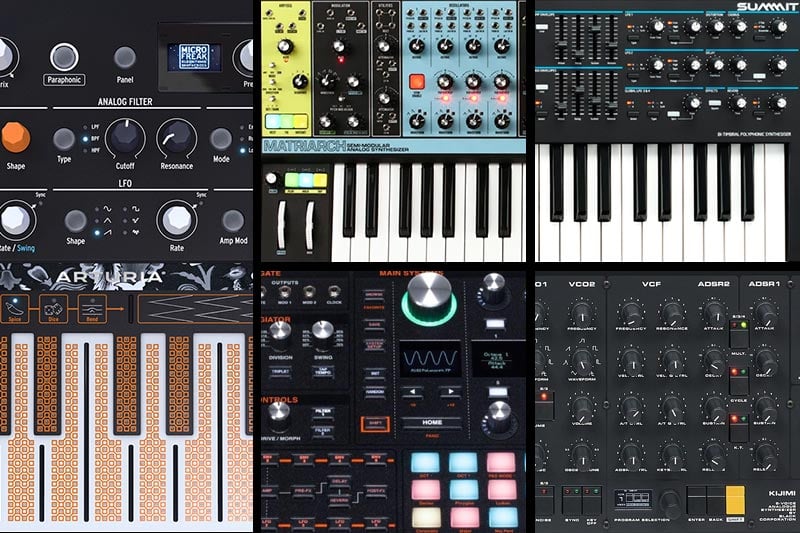2019 has seen the release of countless new instruments for electronic music production: Eurorack modules, MIDI controllers, effects pedals, and more. And of course, there has been no shortage of interesting standalone electronic instruments, ranging from analog and digital to hybrid and electromechanical.
In this article, we'll take a look back at some of our favorite standalone synths that came along in 2019—both self-contained and semi-modular, both currently available and some still on the horizon. Of course, it's impossible to come up with a definitive "best of" list, so we're simply presenting here a handful of brand new instruments that left us super excited this year...and while by no means exhaustive, hopefully it'll help to explain what we think is so special about each of these awesome instruments. And fret not, we'll tackle pedals, Eurorack modules, and drum machines in forthcoming articles...but for now, let's talk synths.
Multi-Timbral Masterpiece: Novation Summit
Novation's Summit is an all-out, full-fledged keyboard synth—basically two Peaks in a keyboard package, fully capable of bi-timbral operation for huge, layered sounds. Bearing the same basic signal flow as the Peak, it uses "numerically controlled" New Oxford Oscillators and wavetables to provide a huge range of core sounds which are eventually processed by analog distortion, filters, and VCAs.
Summit can work in split and layer modes, allowing tons of options for how to combine timbres together. It also offers a mode in which panel controls can be used to affect both timbres simultaneously. This creates remarkably organic linkages between timbres, for huge sounds that seem to move and evolve together. External inputs can even be used as sound sources for synthesis or sent directly to the final effects section, allowing tons of options for processing external sounds.
The Peak is already a much-loved synthesizer for all the sonic variety it offers by itself. For the tons of people who we've heard half-jokingly suggest that they want two peaks, the Summit just might provide a compelling solution. If you're curious about what else makes the Summit so special, read more here.
MPE Playground: Black Corporation Kijimi
Following the success of the CS-80 inspired Deckard's Dream, Black Corporation finally released Kijimi into the wild. Kijimi is another rack-format synthesizer that bears some resemblance to the Deckard's Dream: it is analog, eight-voice polyphonic, offers plenty of easy MPE implementation, and best of all, it sounds great.
This time taking inspiration from the super-rare RSF Polykobol, Kijimi thrives on complex modulation and expressive playing. It can produce enormous, engrossing pads like its older sibling, but its strong suit lies in all of its potential for modulation. Using a pseudo matrix-style routing scheme, Kijimi provides access to a ton of modulation paths. Especially when making use of its continuous waveshape modulation, it becomes possible to make sounds quite unlike most analog polysynths...and when paired with clever use of incoming data from a suitable MPE controller (like a Sensel Morph or Keith McMillen K-Board Pro 4, for instance), these sounds can take an uncommonly expressive, organic turn.
Black Corporation once again provides a remarkably deep synthesizer that makes excellent use of the solidifying MIDI Polyphonic Expression protocol—and we're excited to see synthesizer design finally taking a turn for the more expressive. Check out more about MPE and Kijimi here.
Amazing Value: Arturia Microfreak
Arturia's Microfreak is one of the best bargains in a synth all year. Certainly a peculiar offering, the Microfreak pairs a digital oscillator with an analog filter for the best of both sides of the hybrid coin. It borrows oscillator models from the Mutable Instruments Plaits, with countless control options...including a PCB touchplate keyboard, cycling envelope, and an integrated arpeggiator and sequencer which favor experimentation with chance and randomness.
On paper, the Microfreak is labeled as being paraphonic...though the inner workings of its oscillators means that true polyphony is possible under some circumstances. Microfreak contains many synthesis algorithms that simply don't depend on traditional subtractive synthesis workflows, including multiple physical modeling modes which emulate the behaviors of plucked or struck objects. And this is one of the Microfreak's most interesting points: it brings complex synthesis methods previously present only in considerably more expensive/inaccessible hardware to a much lower price point.
For more about what makes the Microfreak so special, check out our article on its strong points here.
Paraphonic Powerhouse: Moog Matriarch
Announced at Moogfest 2019, the Matriarch is a welcome expansion to the ideas set forth in the Grandmother: it is a solidly-built, colorful keyboard synth that combines all the best parts of a self-contained keyboard with all the best parts of a modular synthesizer. Semi-modular in nature but with a well-considered default signal flow, the Matriarch has already found a home with keyboardists and modular enthusiasts alike.
The Matriarch is a four-oscillator, dual-filter paraphonic keyboard synth with built-in analog delay, as well as an internal sequencer and arpeggiator. Without patching, it excels at creating enormous stereo sounds, and is capable of monophonic operation as well as two- and four-note paraphony. With some clever patching, though, the Matriarch's oscillators, filters, and amplifiers can be set to operate with relative independence, enabling performance techniques ranging from polyphonic generative textures to almost groovebox-like counterpoints.
While many keyboards are truly for keyboard players alone, the Matriarch feels more like an open-ended analog ecosystem for all sorts of musicmaking, providing every bit as much opportunity for keyboardists as it does for those more accustomed to patching—and hopefully, bringing those worlds closer together. For more about the Matriarch's inner workings, be sure to check out this article, where we dive deeper into its specific strong points.
Best in Show: ASM Hydrasynth
ASM's Hydrasynth has to be one of the most exciting developments of the year. ASM is a completely new company, but they have come out the gate with a remarkably well-thought-out instrument that seems to combine all the best features of tons of instruments to create something completely unique. Hydrasynth is available both in keyboard and desktop formats—but happily, there are no sonic compromises in either form. Both use exactly the same voice architecture, only with differences in form factor.
Hydrasynth is an eight-voice synthesizer with tons of modulation and sound shaping options. The keyboard version features a full-length ribbon controller and full-size keys with polyphonic aftertouch; the desktop version loses the ribbon but substitutes the poly-AT keys with backlit pads...which are also capable of polyphonic aftertouch. Of course, it can still be used with external controllers—but it's nice that it can still act as a self-sufficient instrument without need any other gear (unlike many desktop synths).
The heart of the Hydrasynth are its wave-morphing oscillators and dynamic waveshaping tools called Mutators—which we discuss in greater depth in this article. It also offers two remarkably deep filters per voice, five LFOs per voice, five envelopes per voice, dedicated effects, an an insane modulation matrix: in short, Hydrasynth is a sound designer's dream, and will no doubt inspire musicians and synth lovers from all corners of the music industry. For more info about the Hydrasynth, check out our interview with its design director Glen Darcey. He provides a ton of insight as to how and why the Hydrasynth does what it does, leaving us all the more excited for its existence. Synths like this don't come along often, and we're super glad this one has arrived.
Self-Contained Synths on the Horizon
Of course, 2019 revealed a ton of amazing synths yet to come. UDO's Super 6 has been the talk of the keyboard world, providing a distinctly Roland-like look and workflow while combining all the best possibilities of FPGAs, analog tech, and high-resolution DSP. Its "super-wavetable" synthesis, rich digital effects, and complex modulation matrix combined with super high-quality build have left countless synthesists eager to give it a try. As of now it's expected in early 2020...our fingers are crossed!
Modal's Argon8 was revealed at Knobcon, and promises polyphonic wavetable performance at a bargain price. Featuring 24 banks of five morphable waveform sets, two-pole morphing filter, a powerful effects engine, and eight voice polyphony, Argon8 seems like a no-brainer—and we're excited to get our hands on them.
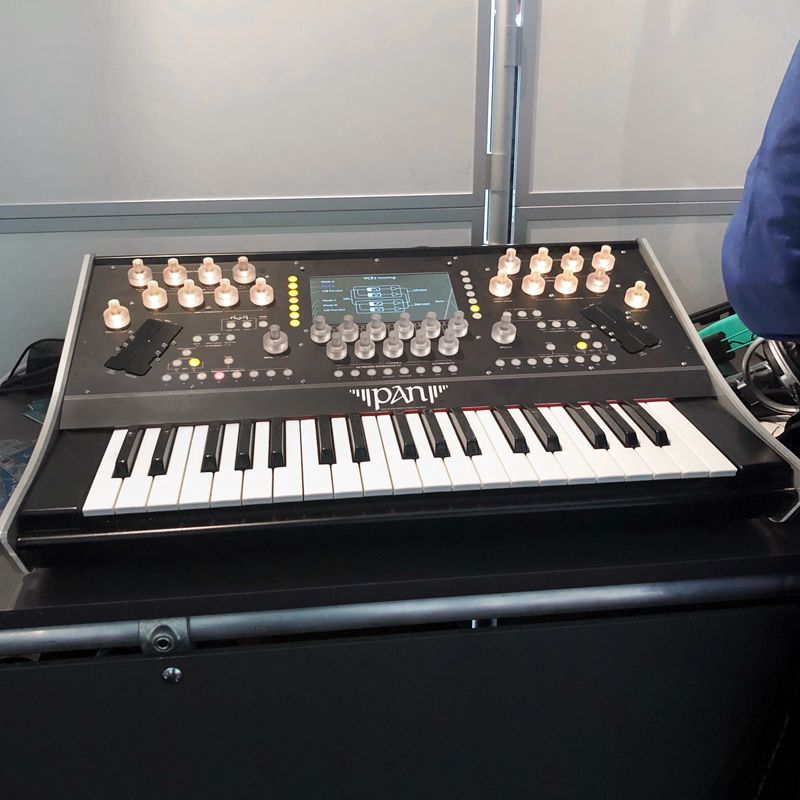 Syntonovo Pan at Superbooth 2019
Syntonovo Pan at Superbooth 2019
Decidedly on the boutique end of the spectrum, Superbooth 2019 saw an update of the Syntonovo Pan, rife with luminescent knobs and the promise of infinite internal modulation. Pan seems like a logical 21st-century continuation of the ideas in the Syrinx (one of our favorite vintage monosynths), but adds 3D expressive control from a proprietary keyboard, digital internal modulation, and a surprisingly open-eneded workflow when compared to most keyboards.
And then there's the Motor Synth: yet another peculiarity from the imaginative folks at Gamechanger Audio. Following their mind-bending PLUS pedal and the Plasma family of distortion effects (in pedal, rack, and module format), the Motor Synth seems a step in an entirely different direction. Motor Synth is an electromechanical instrument based on generating sound from spinning motors. And while this might seem a bit gimmicky on paper, the Motor Synth is capable of a huge range of sounds. They're expected to start making it out into the world in late 2019/early 2020.
Best Semi-Modular Synths of 2019
Happily, there has been no shortage of semi-modular synths this year—many offering unique, novel, and affordable ways of getting into the modular synth workflow without needing to dive right in to the deep end of Eurorack. Ranging from near pocket-sized synths to quirky DIY adventures, these are some of our favorite semi-modular synths from 2019.
DIY Synth Trio: Teenage Engineering PO Modular
2019 saw Teenage Engineering, creators of the OP-1 and OP-Z, take a step into an unexpected direction: DIY modular synthesizers. The PO Modular 16, PO-170, and PO-400 are affordable modular devices that provide an easy and attractive entry point into the world of modular synths. They need to be assembled by the end user, which can be tedious...but happily, they do not require any soldering, meaning that virtually anyone can assemble one if approached with some time and patience.
The PO Modular 16 is a touch controller & sequencer not unlike the Serge TKB—it doesn't produce any sound of its own, but it could prove to be a particularly powerful pairing with another synthesizer, such as a Make Noise 0-Coast, Moog Mother 32, or basically any other modular system. The PO-170 pairs the controller of the PO-16 with a simple complement of modules in order to create a standalone instrument with keyboard controller. Its voice architecture is fairly simple (LFO, Square wave oscillator, Filter, Envelope, and VCA), but plenty for getting classic monophonic synth lines and sound effects.
The PO-400 is perhaps the most eye-grabbing and certainly the most powerful of the three. The 400 is a remarkably powerful synth considering the price point and size, with three oscillators, filter, two VCAs, built-in sequencer, and plenty of modulation options. And while the Lego-style knobs can be a bit fiddly, the PO-400 truly has an interesting, characterful sound and will no doubt capture the attention of plenty of folks excited about getting into modular synths who aren't quite ready to take the plunge of buying an entire Eurorack system.
West Coast on a Budget: Korg Volca Modular
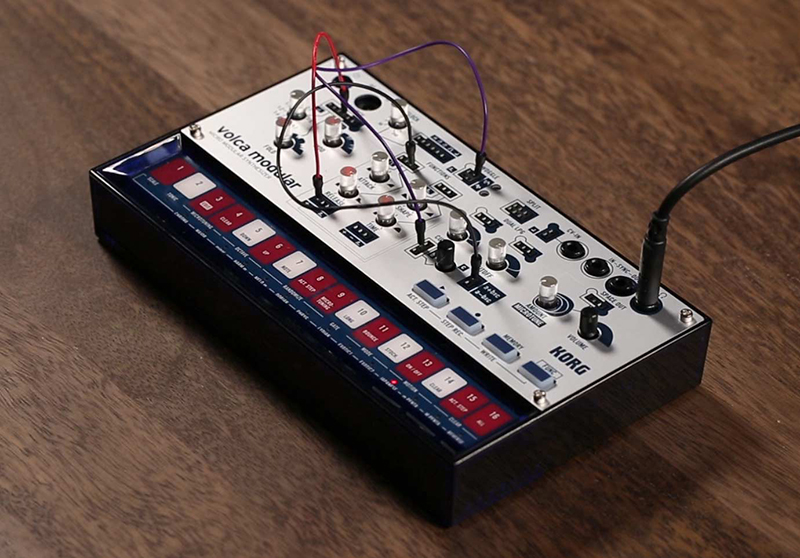 Korg's Volca Modular—an affordable West Coast synthesizer
Korg's Volca Modular—an affordable West Coast synthesizer
Korg's Volca Modular is decidedly one of the most bold synthesizers of the year: a nearly pocket-sized synth with a Buchla-style workflow for under $200 (for more thoughts about its similarities to the Music Easel, check out this article). No doubt the weirdest of the Volca line, the Volca Modular feels like a small step into the esoteric for Korg (makers of performance keyboards and workstations)—and one that they pulled off excellently.
The Volca Modular is one of several semi-modular synths announced this year that draw obvious influence from the Buchla Music Easel. With its blue and red color scheme, wavefolding, FM, Lowpass Gates (LPGs) and random voltage generation, it must be the most affordable West Coast-inspired synth available. And while not everyone out there will immediately jive with its breadboard jumper-style patching workflow, it does provide a ton of potential for sonic experimentation—bringing modular synth-style techniques to an entirely new audience.
Volca Modular also includes a built-in sequencer with randomization, "exotic" scales, and the option for microtonal tuning, as well as a swampy, reverb-like "Space Out" effect that harkens back to the relationship between early synths and 1960s/70s West Coast counterculture. And while the Volca Modular's patch cables are tiny, its sounds are decidedly huge—making this synth one of the most surprising and interesting new instruments of the year.
Industrial Easel: Erica Pico System III
Seemingly out of nowhere, Erica's Pico System III emerged this fall and was on our doorstep in no time. Much like the Volca Modular, it seems to draw inspiration from the Buchla Music Easel, though taking different cues from this classic instrument's design to create something distinct and unique.
Unlike the previous Pico System I and II, the Pico System III is not comprised of individual, replaceable modules: while it does have a fully modular signal flow, all modules are firmly located behind one panel with the vision of functioning as a self-sufficient (albeit tiny) system. Featuring a sequencer, two VCOs (with modulation bus), LFO, looping envelopes, two LPGs, voltage-controllable BBD delay, and three mixers, it has plenty of resources for the creation of all sorts of timbres—and despite its seeming West Coast leanings, it provides the grit and power one expects from Erica, turning the classic Buchla workflow into something much more intense than you might expect.
One of the most obvious points of inspiration drawn from the Music Easel is the program card interface: the exposed blue edge connector on the left side of the instrument. This is a decidedly old-school means of preset memory—a way of "storing" patch connections on a solderable PCB. In the Pico System III, you can only store patch routings and not knob positions—but this still leaves plenty of potential for experimentation. It comes with several factory "cards" that will give you an idea of how flexible this interface can be: but the real fun lies in creating your own cards.
Pico System III is available both in Eurorack and standalone desktop formats, making it easy to integrate into almost any workflow. It does not have an integrated MIDI interface, but with so many options for internal control and so many CV patch points, we don't really miss direct MIDI integration.
An Organic Synth: Pittsburgh Voltage Research Lab
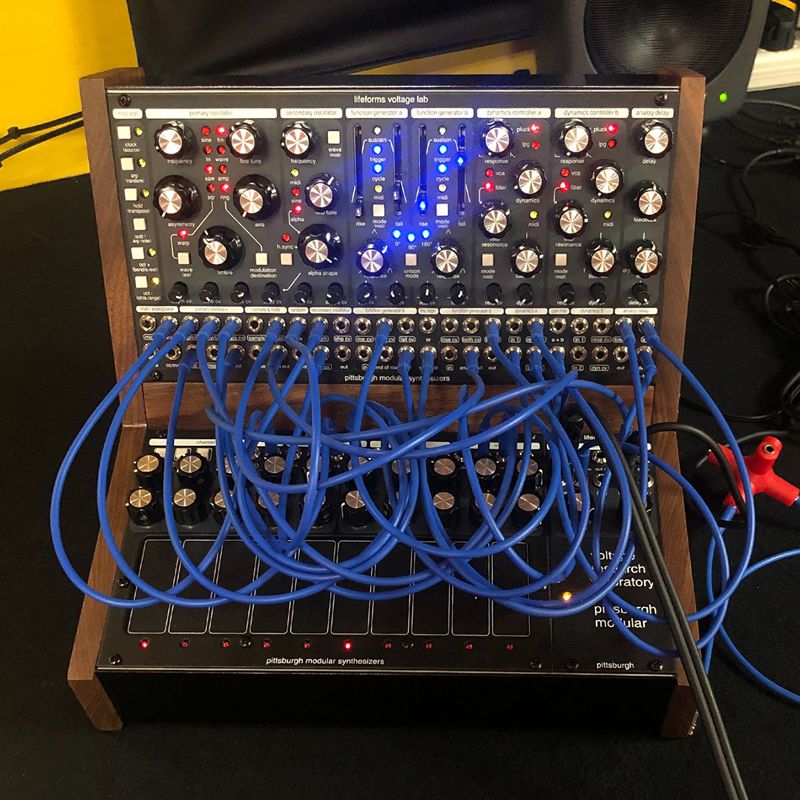 Voltage Research Lab at Superbooth 2019
Voltage Research Lab at Superbooth 2019
Pittsburgh'sVoltage Research Lab is what they refer to as "an organic synthesizer": a device which produces electronic sounds in such a way that it would sound at home in the natural world...perhaps in a jungle or a dark lagoon. Again seemingly drawing inspiration from the Buchla Music Easel, the VRL offers access to tons of West Coast techniques, focusing on the potential for deep, rich timbres and knotted webs of organic modulation.
The VRL is essentially a small (yet dense) modular system comprised of a few elemental pieces. The Lifeforms Voltage Lab is the VRL's voice module; it features a dual oscillator, dual function generator, dual LPG, and a voltage-controllable analog delay. And of course, it is rife with CV options, including randomness, a sample and hold, logic, CV mixing, and MIDI to CV conversion (with arpeggiation and more). It expands an Easel-like palette with entirely new waveshaping methods, resonant filtering, and a CV-able delay. The Lifeforms Touch Controller module is a hybrid touch keyboard/sequencer seemingly inspired by the Serge TKB, with considerably more complex options for "channel animation." It provides the VRL a tactile interface for duophonic keyboard performance, gestural control, and classic sequencing options.
Tied together with a dedicated output module and the Voltage Research Console case, the Voltage Research Lab is a perfect instrument for adventurous musicians, providing ample territory for exploration and experimentation. The Voltage Research Lab is available as a full instrument, but the voice module (the Lifeforms Voltage Lab) is available for use in Eurorack systems, and as its own standalone device (the Voltage Lab Blackbox).
Semi-Modular On the Horizon
And of course, 2019 left us with some product teases and announcements that have us eager to see what will come in 2020. Manufacturers are often eager to show off their new projects early in the course of development in order to capture attention and gauge the public's interest. Having visited NAMM, Synthplex, and Superbooth this year, we saw plenty of amazing instruments that still haven't quite made it into our hands—but they give us something to look forward to.
 SOMA Pulsar-23 at Superbooth 2019
SOMA Pulsar-23 at Superbooth 2019
While arguably more a drum machine than a synthesizer, SOMA's Pulsar-23 is rife with patch points and seemingly eager for experimentation—capable of straightforward beat making and wild sonic experimentation, it breaks the typical "drum machine" mold in favor of amorphous textures and bursts of rhythmic noise.
Of course, Behringer continued their charge into the world of synthesizer production, following up the success of their Model D and Neutron desktop semi-modulars with the release of the SH-1 and VC340 keyboards. In the meantime, they have announced several more semi-modular desktop synths based on classic designs: the K-2, drawing clear inspiration from the Korg MS-20, the Crave (a mix of several designs), and the Pro-1, based on...well, the Pro-One. As of the time of writing, all of these are still on the way—but definitely something to look forward to.
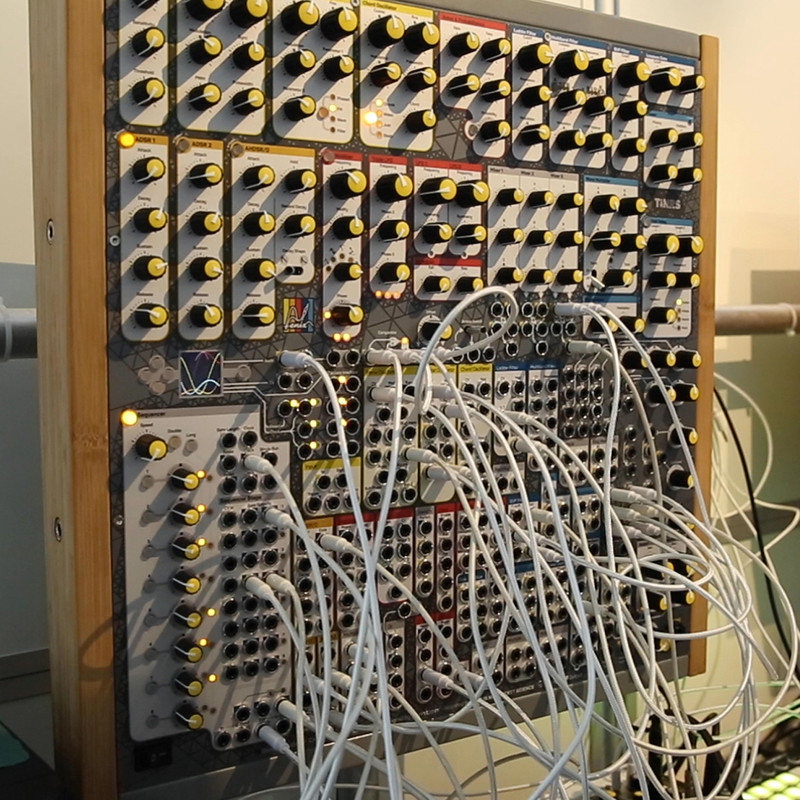 TINRS/Synton Fenix IV at Superbooth 2019
TINRS/Synton Fenix IV at Superbooth 2019
Perhaps one of the most exciting announcements of 2019 was the Fenix IV, produced in collaboration between TINRS and Syntonovo. Continuing the legacy of high-quality, no-holds-barred instrument design from the prior members of the Synton Fenix family, the Fenix IV presents its own peculiar combination of modern techniques: a Fenix decidedly from the modern era. With bold, colorful graphics, an enormous patchbay, a combination of digital and analog sound generation and processing, and an insane set of modulation possibilities, the Fenix IV is going to be a formidable and deep instrument.
Given the quality and reputation of the prior generations of Fenix, we hope to see more of this in 2020—and expect to spend a lot of time with it afterward.
Tons of new gear came out this year, all of it worth attention—and it would be impossible to talk about all of it. This has just been an informal list of some of the synths that got us most excited this year...and some that have us looking forward to next year. No doubt more will come along in the meantime, and our tastes may change...but 2019 was a heck of a year for synths.
Again, keep your eyes open for our thoughts on 2019's coolest Eurorack modules, pedals, and more.

